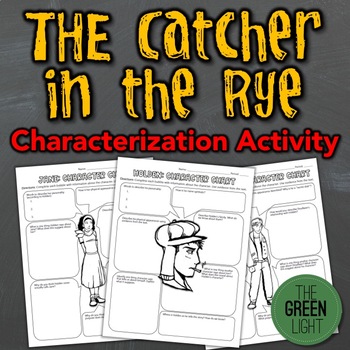The Catcher in the Rye Characterization Activity, Worksheets
The Green Light
2.7k Followers
Grade Levels
8th - 11th, Homeschool
Subjects
Resource Type
Standards
CCSSRL.11-12.1
CCSSRL.11-12.2
CCSSRL.11-12.3
CCSSRL.11-12.4
CCSSRL.11-12.10
Formats Included
- PDF
Pages
11 pages
The Green Light
2.7k Followers
Description
Freshen up your lesson plans and help your students begin to analyze the characters in J.D. Salinger's novel, The Catcher in the Rye. Students analyze the given prompts based on the text to determine what it suggests about the character.
Character included are:
• Holden
• Mr. Spencer
• Allie
• Phoebe
• Jane Gallagher
• Stradlater
• Ackley
• Sally Hayes
• Maurice
• Sunny
• Mr. Antolini
Aside from individual classwork, use these 11 worksheets as a quick group activity (each group takes a different character), as bell-ringers or exit slips, or even as a quick quiz. These ready-to-print handouts, can also make a good review activity once you've finished the novel.
Want more resources for The Catcher in the Rye? Check out these task cards:
The Catcher in the Rye Task Cards: Quizzes, Discussion Questions, Bell-Ringers
Clip-art provided by Illumismart
Character included are:
• Holden
• Mr. Spencer
• Allie
• Phoebe
• Jane Gallagher
• Stradlater
• Ackley
• Sally Hayes
• Maurice
• Sunny
• Mr. Antolini
Aside from individual classwork, use these 11 worksheets as a quick group activity (each group takes a different character), as bell-ringers or exit slips, or even as a quick quiz. These ready-to-print handouts, can also make a good review activity once you've finished the novel.
Want more resources for The Catcher in the Rye? Check out these task cards:
The Catcher in the Rye Task Cards: Quizzes, Discussion Questions, Bell-Ringers
Clip-art provided by Illumismart
Total Pages
11 pages
Answer Key
N/A
Teaching Duration
1 Week
Last updated Aug 17th, 2018
Report this resource to TPT
Reported resources will be reviewed by our team. Report this resource to let us know if this resource violates TPT’s content guidelines.
Standards
to see state-specific standards (only available in the US).
CCSSRL.11-12.1
Cite strong and thorough textual evidence to support analysis of what the text says explicitly as well as inferences drawn from the text, including determining where the text leaves matters uncertain.
CCSSRL.11-12.2
Determine two or more themes or central ideas of a text and analyze their development over the course of the text, including how they interact and build on one another to produce a complex account; provide an objective summary of the text.
CCSSRL.11-12.3
Analyze the impact of the author’s choices regarding how to develop and relate elements of a story or drama (e.g., where a story is set, how the action is ordered, how the characters are introduced and developed).
CCSSRL.11-12.4
Determine the meaning of words and phrases as they are used in the text, including figurative and connotative meanings; analyze the impact of specific word choices on meaning and tone, including words with multiple meanings or language that is particularly fresh, engaging, or beautiful.
CCSSRL.11-12.10
By the end of grade 11, read and comprehend literature, including stories, dramas, and poems, in the grades 11-CCR text complexity band proficiently, with scaffolding as needed at the high end of the range.By the end of grade 12, read and comprehend literature, including stories, dramas, and poems, at the high end of the grades 11-CCR text complexity band independently and proficiently.





